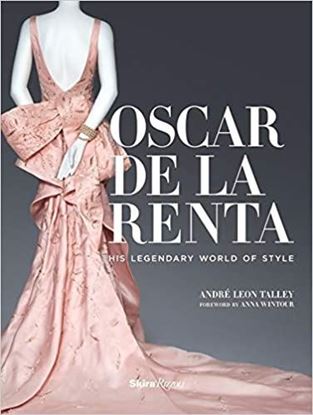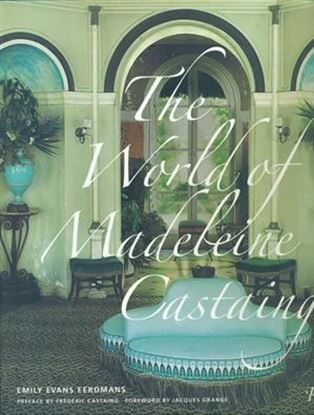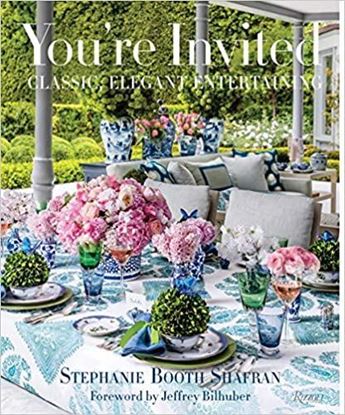

OSCAR DE LA RENTA
A sumptuous monograph tracing the life and legacy of fashion luminary Oscar de la Renta. In October 2014 one of the fashion world’s champions, Oscar de la Renta, passed away, a great loss brightened by the innumerable successes of his half-century reign. The acclaimed fashion designer dressed first ladies from Kennedy to Obama, and celebrities from Beyoncé to Sarah Jessica Parker. Renowned for his unique charm, impeccable taste, and original lifestyle, he married the highest standards of French couture with the ultimate motivation that women must look and feel beautiful.
In this intimate volume, longtime editor and friend André Leon Talley recounts de la Renta’s journey through nearly 70 iconic dresses, mainly made for private clients, accompanied by fascinating stories of the exquisite craftsmanship and the legendary friends that brought each gown to life. Born in the Dominican Republic in 1932, de la Renta left for Madrid at nineteen to study art, where he rose to prominence as a sketch artist for newspapers and fashion houses. From his apprenticeship under Cristóbal Balenciaga to his eponymous collections, the designer’s simple lines elevated with a flamenco dancer’s flourish reflect his deep connection to his roots and his commitment to transcendence through beautiful garments.
4,300
THE WORLD OF MADELEINE CASTAING (OF3)
The inimitable style of renowned French interior designer Madeleine Castaing, chronicled in-depth for the first time. While many were drumming to the beat of modernism in the early- and mid-twentieth century, French antiquaire and decorator Madeleine Castaing created her own look that was a unique blend of neoclassicism, Proustian romanticism, and pure wit. Her distinctive aesthetic vision has inspired tastemakers on both sides of the Atlantic, and her devotees--both then and now--are legion. Ocelot carpeting, opaline blue, "coolie" lampshades, and an eclectic mix of neoclassical furnishings ranging from English Regency to Napoleon III all formed part of the vocabulary of "le style Castaing." This lavishly illustrated volume--the first on her work--explores in-depth the elements of her style, and examines how she crafted interiors so emotive that visitors felt that they had stepped into a Balzac novel or a Proustian recollection. Her entire life and career are chronicled, from her early years in Montparnasse, the epicenter of artistic activity in Paris, to her incomparable country house Leves and her legendary shop on rue Jacob in Paris.
999
YOU`RE INVITED
In her first book, noted hostess Stephanie Booth Shafran shares her secrets for planning and giving brilliantly executed parties at home.
Taking at-home entertaining to an entirely new level, sophisticated L.A. hostess Stephanie Booth Shafran--recently named by the Salonniere as one of the top hostesses in Los Angeles--has a gift for celebration. From the table settings to the decor to the color-coordinated menus, every party she hosts showcases a myriad of inspired elements. In her first book, she shows readers how to set the stage for eight parties, from an elegant housewarming in her Jeffrey Bilhuber-decorated home to a classic California pool party to a festive Christmas brunch. She also shares advice on palette creation--blue and white for a ladies' charity luncheon, and deep burgundies for a gentleman's wine and cigar party. Each chapter ends with tips for that theme, whether it is entertaining alfresco or having parties for a charitable purpose. Shafran also includes a guide to her party essentials: inspiration, invitations, flowers, tablescape, linens, seating, the bar, and select recipes
3,800
ARQUITECTURA. FORMA, ESPACIO Y ORDEN
Esta introducción clásica a los principios de la arquitectura analiza de manera sistemática y exhaustiva los fundamentos de la forma, el espacio y la ordenación arquitectónicos a partir de prototipos y de ejemplos históricos de todas las épocas, culturas y ámbitos geográficos. Partiendo de los elementos primarios hasta llegar a las composiciones arquitectónicas más complejas, el libro examina la cadena secuencial que va desde el punto, la línea, el plano y el volumen hasta la forma, el espacio, la organización, la circulación, la proporción, la escala y los principios ordenadores.
3,500
DIBUJO Y PROYECTO
El dibujo es una herramienta cognitiva y creativa fundamental a la hora de abordar el proyecto arquitectónico. Bajo esta premisa Francis D. K. Ching nos ofrece en este libro una guía de referencia con la que aprender a utilizar el dibujo como técnica para pensar el proyecto.Organizado en tres grandes bloques que pasan de lo más descriptivo a lo especulativo dibujo por observación, sistemas convencionales de representación gráfica y dibujo imaginativo, el libro explica paso a paso la gran multiplicidad de conceptos y técnicas que entran en juego en el dibujo arquitectónico: desde los principios básicos de la expresión gráfica (la línea, la forma, la sombra o el espacio), hasta los sistemas de representación más frecuentes (el sistema diédrico, la axonometría y la perspectiva cónica) o los innumerables conceptos y herramientas existentes (tales como el rayado, la orientación, la escala, la estratificación o la diagramación).Además de los 1.500 dibujos ilustrados a mano y los cerca de 140 ejercicios que incluye el libro, esta nueva edición ampliada incorpora técnicas de dibujo por ordenador e incluye un CD con tutoriales. El estudiante de arquitectura y el arquitecto encontrarán en estas páginas una ayuda práctica y didáctica no solo para representar los proyectos, sino también para pensar espacialmente.
3,300













